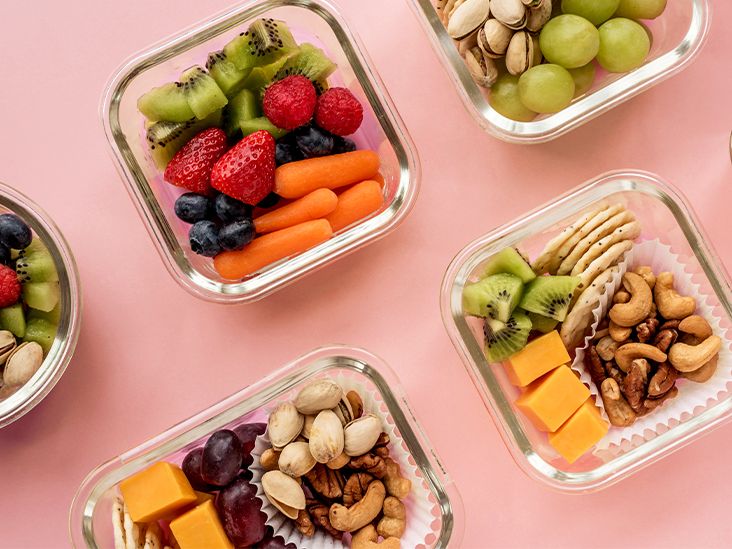Eating various nutritious foods, including fruit, vegetables, nuts, seeds, and lean protein, can help support your overall health.
Many foods are both healthy and tasty. By filling your plate with fruits, vegetables, quality protein sources, and other whole foods, you’ll have meals that are colorful, versatile, and good for you.
Here are 50 healthy and delicious foods to include in your diet.
What makes a food healthy?
Typically, the foods people consider healthy are whole foods that contain beneficial nutrients. They are also low in saturated fat and sodium and do not contain additives like sweeteners. This can include:
- foods high in macronutrients, like protein, that support muscle health and help us feel fuller after eating
- essential vitamins and minerals the body needs to function
- antioxidants and phytonutrients, which are compounds found in plants that support human immune function and defend against the cellular damage that can lead to disease
- fatty acids, like omega-3s, that help reduce inflammation in the body
The components that make up nutritious foods may also benefit the body and your overall health.
Fruits and berries are popular health foods.
They are sweet, nutritious, and easy to incorporate into your diet because they require little to no preparation.
1. Apples
Apples contain fiber, vitamin C, and numerous antioxidants. They are very filling and are a good snack if you’re hungry between meals.
2. Avocados
Avocados are different from most other fruits because they contain lots of healthy fat. They are not only creamy and tasty but also high in fiber, potassium, and vitamin C. Swap mayonnaise for avocado as a salad dressing, or spread it on toast for breakfast.
3. Bananas
Bananas are a good source of potassium. They’re also high in vitamin B6 and fiber and are convenient and portable.
4. Blueberries
Blueberries are both delicious and high in antioxidants.
5. Oranges
Oranges are well known for their vitamin C content. They’re also high in fiber and antioxidants.
6. Strawberries
Strawberries are highly nutritious and low in both carbs and calories.
They provide vitamin C, fiber, and manganese and make a delicious dessert.
Other healthy fruits
Other healthy fruits and berries include cherries, grapes, grapefruit, kiwi, lemons, mangoes, melons, olives, peaches, pears, pineapples, plums, and raspberries.

Eggs are highly nutritious.
Lean, unprocessed meats can be included in a healthy diet.
8. Lean beef
Lean beef is an excellent source of protein if you consume it in moderation. It also provides highly bioavailable iron. Bioavailable means your body can absorb and use the iron more readily.
9. Chicken breasts
Chicken breast is low in fat and calories but high in protein. It’s a great source of many nutrients, including potassium and B vitamins.
10. Lamb and mutton
Sheep are usually grass-fed, and their meat tends to be
Although high in unsaturated fat and calories, nuts and seeds
They also require almost no preparation, so they’re easy to add to your routine. They can also add texture to salads and other dishes.
However, they are not suitable for people with a nut allergy.
11. Almonds
Almonds are a popular nut that contains vitamin E, antioxidants, magnesium, and fiber. A
12. Chia seeds
Chia seeds are a nutrient-dense addition to the diet. A single ounce (28 grams) provides
13. Coconuts
Coconuts provide fiber and fatty acids called medium-chain triglycerides (MCTs).
14. Macadamia nuts
Macadamia nuts are tasty and higher in monounsaturated fats and lower in omega-6 fatty acids than most other nuts.
15. Walnuts
Walnuts are highly nutritious and rich in fiber and various vitamins and minerals. Pair them with feta cheese to dress a salad.
16. Brazil nuts
Brazil nuts are nutrient-rich and have a smooth, buttery texture. The nutrients they contain support thyroid function and are a good source of the mineral selenium.
Calorie for calorie, vegetables are among the most concentrated sources of nutrients. Many of these varied nutrients also give vegetables their colors, so eating a wide variety of vegetables in different colors is a good way to ensure you get a diverse range of nutrients.
17. Asparagus
Asparagus is a popular vegetable that is low in both carbs and calories and rich in vitamin K.
18. Bell peppers
Bell peppers come in several colors, including red, yellow, and green. They’re crunchy and sweet and are a great source of antioxidants and vitamin C.
19. Broccoli
Broccoli is a cruciferous vegetable that tastes great both raw and cooked. It’s an excellent source of fiber and vitamins C and K and contains a decent amount of protein compared with other vegetables.
20. Carrots
Carrots are a popular root vegetable. They’re sweet, crunchy, and loaded with nutrients such as fiber and vitamin K. They’re also high in carotene antioxidants, which have numerous benefits.
Put a few carrot sticks in your lunchbox or use them to eat guacamole and other dips.
21. Cauliflower
Cauliflower is a very versatile cruciferous vegetable. You can add it to curries, roast it with olive oil, or use it raw in salads or for dipping.
22. Cucumber
Cucumbers make a refreshing snack. They are low in both carbs and calories, consisting mostly of water. They also contain small amounts of vitamin K and other nutrients.
23. Garlic
Garlic is a healthy and tasty addition to salads and cooked savory dishes. It contains allicin, which has antioxidant and antimicrobial effects. Its nutrients may also reduce the risk of cancer and cardiovascular disease.
24. Kale
Kale is high in fiber, vitamins C and K, and other nutrients. It adds a satisfying crunch to salads and other dishes. You can also add it to stir-fries or bake it in the oven to make crunchy kale chips.
25. Onions
Onions have a strong flavor and are found in many recipes. They contain a number of bioactive compounds believed to have health benefits.
26. Tomatoes
Tomatoes are usually categorized as a vegetable, although they are technically a fruit. They are tasty and provide nutrients such as potassium and vitamin C. For a bit of fun and extra flavor, try growing tomatoes on your windowsill.
More healthy vegetables
Other vegetables worth mentioning are artichokes, Brussels sprouts, cabbage, celery, eggplant, leeks, lettuce, mushrooms, radishes, squash, Swiss chard, collard greens, turnips, and zucchini.
Fish and other seafood can be healthy and nutritious. They’re rich in omega-3 fatty acids and iodine.
Research
27. Salmon
Salmon is an oily fish that is tasty and high in nutrients, including protein and omega-3 fatty acids. It also contains some vitamin D.
28. Sardines
Sardines are small, oily, and highly nutritious fish. They provide many nutrients, including calcium and vitamin D.
29. Shellfish
Shellfish are nutrient-dense and make a tasty light meal. Edible shellfish include clams, mollusks, and oysters. Be sure to get them from a reputable source to ensure they are fresh and toxin-free.
30. Shrimp
Shrimp is a type of crustacean related to crabs and lobsters. It tends to be low in fat and calories but high in protein. It also provides zinc.
31. Trout
Trout is another type of delicious freshwater fish, similar to salmon.
32. Tuna
Tuna tends to be low in fat and calories and high in protein. It’s a good option for people who need to add more protein to their diets but keep calories low.
Be sure to buy low-mercury varieties that are responsibly sourced.
Whole grains play an important role in your diet because they are healthy carbohydrates and provide a variety of micronutrients, fiber, and fuel for your body.
They may also help with weight management.
33. Brown rice
Rice is a staple food for much of the world’s population. Brown rice is more nutritious than white rice, with decent amounts of fiber, vitamin B1, and magnesium.
34. Oats
Oats provide nutrients and powerful fibers called beta-glucans. Glucans provide numerous benefits, including helping lower cholesterol and feeding beneficial gut bacteria.
35. Quinoa
Quinoa is a tasty grain that’s high in nutrients such as fiber and magnesium. It is also an excellent source of plant-based protein.
Whole grain breads can be high in fiber and other nutrients, and are a better choice than highly processed white bread.
When buying bread, compare product labels and look for those with the most dietary fiber and the least added sugar.
If you make your own bread, you’ll know exactly what goes into it. A bread-making machine can help if you’re not sure about baking.
36. Ezekiel bread
Ezekiel bread is made from organic sprouted whole grains and legumes.
37. Homemade low carb and gluten-free breads
If you’re looking for low carb or gluten-free breads, you might want to consider making your own.
Legumes are a great plant-based source of protein, iron, and fiber.
Legumes can sometimes interfere with digestion and nutrient absorption, but soaking and properly preparing them can reduce this risk.
38. Green beans
Green beans, also called string beans, are an unripe variety of the common bean. Use them whole as a side dish or add them cold to salads.
39. Kidney beans
Kidney beans contain fiber and various vitamins and minerals. Make sure to cook them properly, because they’re toxic when raw.
40. Lentils
Lentils are another popular legume. They’re high in fiber and a good source of plant-based protein.
41. Peanuts
Peanuts are legumes, not true nuts. However, they are tasty and high in nutrients and antioxidants. One
However, if you’re monitoring your calorie intake, you may want to be mindful of your consumption of peanut butter, which is very high in calories and easy to eat in large amounts.
For those who can tolerate them, dairy products are a healthy source of various important nutrients.
People with lactose intolerance may be able to find low-lactose or lactose-free options or take lactase enzyme supplements to eat dairy.
42. Cheese
An ounce of cheese may offer about the same amount of protein as an entire cup (240 ml) of milk. It’s also a tasty addition to many dishes and can replace meat as a source of protein. However, it can be high in fat.
There are many types of cheese, with different flavors and textures. Opt for less processed varieties.
43. Dairy milk
Dairy milk contains vitamins, minerals, protein, and calcium.
A
44. Yogurt
Yogurt is made from milk that is fermented through the addition of live bacteria. It has many of the same health effects as milk, but yogurt with live cultures has the added benefit of friendly probiotic bacteria.
Dietary patterns that include unsaturated fats and oils are considered very healthy.
45. Extra-virgin olive oil
Extra-virgin olive oil is one of the healthiest vegetable oils. It contains heart-healthy monounsaturated fats and is high in antioxidants that have powerful health benefits.
46. Coconut oil
Coconut oil is a saturated fat but contains MCTs and may have similar health effects to olive oil.
However, coconut oil has been
Tubers are the storage organs of some plants. As foods, they are called root vegetables.
47. Potatoes
Potatoes provide potassium and contain a little of almost every nutrient you need, including vitamin C. With their jackets, they are also a good source of fiber.
Potatoes contain more water and are less energy-dense than pasta and rice, and can leave you feeling full, so that you don’t need to eat more. As a result, they may help with weight loss.
48. Sweet potatoes
Sweet potatoes are rich in antioxidants, beta carotene, vitamin A, and other essential nutrients. Eat them baked, mashed, or added to other dishes.
Apple cider vinegar may help regulate post-meal blood sugar levels when consumed with a meal, though more evidence is needed on its effectiveness.
It’s great to use as a salad dressing or to add flavor to meals.
Dark chocolate contains antioxidants known as flavonoids that may help manage cholesterol and reduce the risk of heart disease. However, the amount of chocolate that is usually healthy to eat is not enough to provide significant benefits.
The
Research from 2021 developed a scoring system of food based on 54 attributes covering these nine domains: nutrient ratios, vitamins, minerals, food ingredients, additives, processing, specific lipids, fiber and protein, and phytochemicals. Based on the mean values of this scoring system, the healthiest food categories are:
- legumes
- vegetables
- fruit
- fish and seafood
- sauce condiment
- dairy
- mixed dishes
- beverages
- grains
- meat, poultry, eggs
- fats and oils
- savory snacks and sweet desserts
Of course, whether a particular food is healthier than another ultimately depends on the exact food and any specific ingredients it may contain. It’s a good idea to consult a dietitian to determine exactly what foods are best for you.
According to the Dietary Guidelines for Americans 2020-2025, you should aim to eat a variety of fruit, vegetables, dairy, grains, and foods containing protein (either plant-based or from lean meats or fish) each day.
No one food can provide all the nutrients you need to consume in one day, so eating a balanced diet is the best way to get what you need to stay healthy. In addition, the state of your overall health and any conditions you might have may limit what foods you can consume, even if they are very nutritious. Speak to your doctor to determine the best nutrition plan for you.
That said, research looking at the nutrient density of various food groups found that the following foods contain the most nutrients:
- organ meats
- small fish
- dark green leafy vegetables
- bivalves such as oysters and clams
- crustaceans such as lobster and shrimp
- goat meat
- beef
- eggs
- milk
- canned fish with bones
- mutton
- lamb
Whether you want to overhaul your diet or simply change your meals, it’s easy to add several of these foods to your routine.
Many of the foods above make great snacks or can be incorporated into a meal. Some may even aid weight loss.










